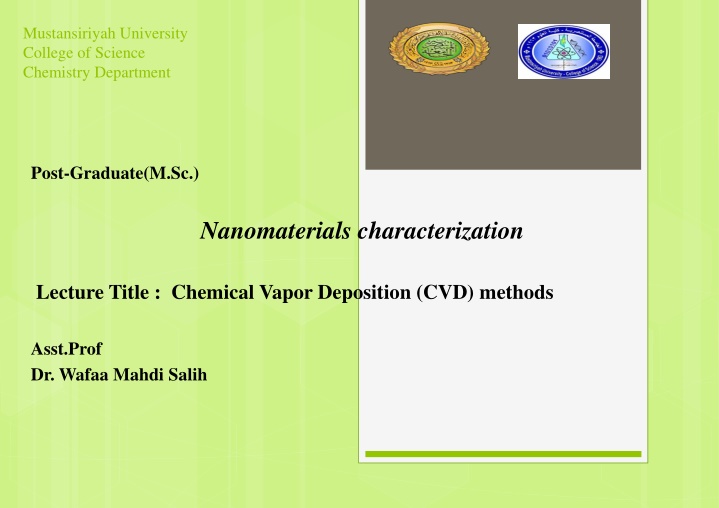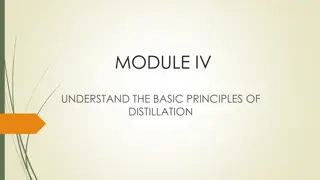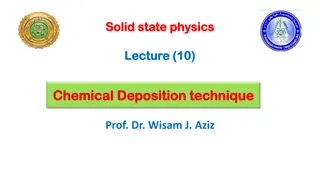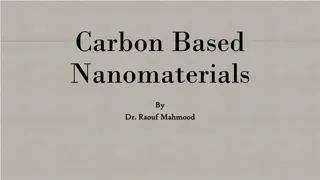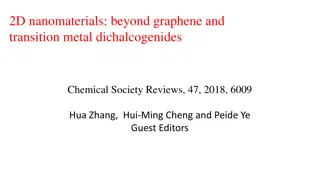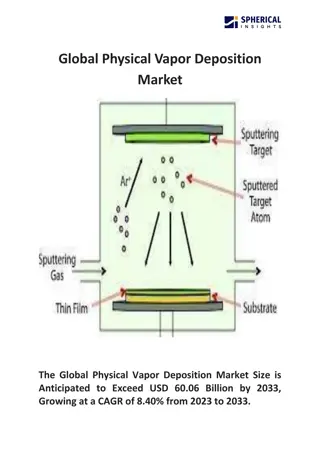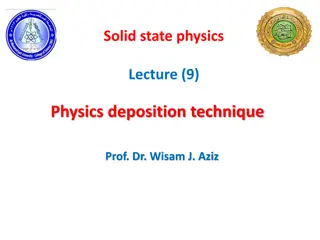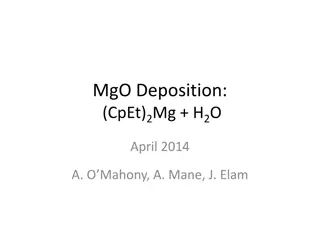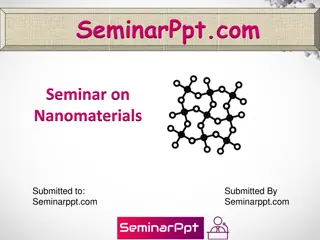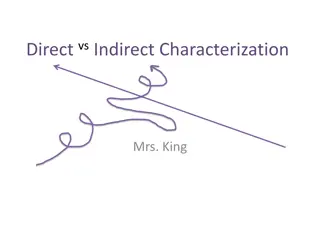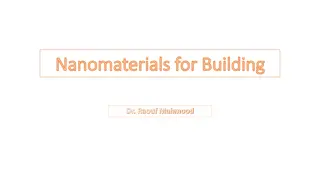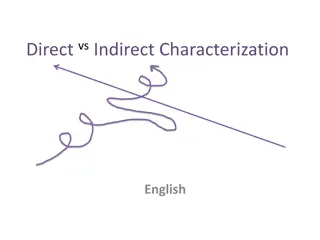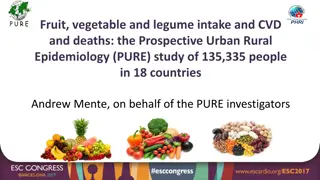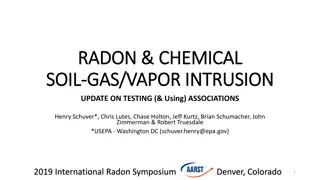Chemical Vapor Deposition (CVD) Methods for Nanomaterials Characterization
Chemical Vapor Deposition (CVD) is a widely used method in the field of nanomaterial synthesis, particularly for growing nanotubes, nanowires, and nanoparticles. The process involves decomposing a gaseous precursor on a substrate with the help of a catalyst, either predeposited or provided in the gas feedstock. Different types of CVD methods such as Thermal CVD and Plasma-Enhanced CVD (PECVD) are utilized for controlled growth of nanomaterials. Various forms of CVD, including Atomic-layer CVD (ALCVD), Metal-organic CVD (MOCVD), and Laser-assisted CVD (LCVD), play a significant role in achieving specific crystalline structures. CVD is commonly used for producing carbon nanotubes (CNTs) and semiconductor nanowires due to its scalability, purity, and high yield.
Download Presentation

Please find below an Image/Link to download the presentation.
The content on the website is provided AS IS for your information and personal use only. It may not be sold, licensed, or shared on other websites without obtaining consent from the author.If you encounter any issues during the download, it is possible that the publisher has removed the file from their server.
You are allowed to download the files provided on this website for personal or commercial use, subject to the condition that they are used lawfully. All files are the property of their respective owners.
The content on the website is provided AS IS for your information and personal use only. It may not be sold, licensed, or shared on other websites without obtaining consent from the author.
E N D
Presentation Transcript
Mustansiriyah University College of Science Chemistry Department Post-Graduate(M.Sc.) Nanomaterials characterization Lecture Title : Chemical Vapor Deposition (CVD) methods Asst.Prof Dr. Wafaa Mahdi Salih
2. Chemical Vapor Deposition The CVD process is now probably the most common of all bottom-up approaches. It is used today to grow structures, like nanotubes, nanowires, and nanoparticles aided by several different types of chambers and growth-enhancing methods. The CVD process consists of: 1- decomposing a gaseous precursor that adheres and accumulates onto a substrate (i.e., a silicon wafer or a quartz slide). 2- The presence of a catalyst, either predeposited on the substrate or provided in the gas feedstock, activates the chemical reaction between the substrate surface and the gaseous precursor. The CVD reaction can be achieved either with temperature (thermal CVD) or with plasma (PECVD). Plasmas can be obtained with DC electric fields, RF fields, or microwave fields. Q/ Why (PECVD) prefers than (thermal CVD) technique? Answer: 1- Plasma fields allows decreasing significantly the process temperature compared to the thermal CVD process. 2- The presence of plasma also enables a more aligned or directional growth of the desired nanomaterial.
Systems forms of CVD are in wide use include: 1- Atomic-layer CVD (ALCVD) in which two complementary precursors [e.g., Al(CH3)3 and H2O] are alternatively introduced into the reaction chamber. 2- Metal-organic CVD (MOCVD) in which metal-organic precursors are used to obtain specific crystalline structures [e.g., tantalum ethoxide, Ta(OC2H5)5, to create TaO nanostructures, and tetra dimethyl amino titanium (TDMAT) to create TiN]. 3- Laser-assisted CVD (LCVD). 4- Rapid thermal CVD (RTCVD) that uses heating lamps or other methods to rapidly heat the wafer substrate. 5- Ultrahigh vacuum CVD (UHVCVD) The CVD process is widely used to produce CNTs and semiconductor nanowires, such as Si, GaN, and ZnO. CNTs have received much attention in the recent years for their potential application in several fields of bioengineering, from enhanced cell growth to biosensing, biomanipulation, and drug delivery. Why the most common synthesis routes for CNTs are CVD processes? because they allow large- scale production of CNTs with high purity and good yield.
Fig 3 Schematics of a thermal CVD furnace (top) and basic flow of a carbon nanotube growth process (bottom) To clarify how the CVD process works, we show a schematic diagram of a thermal CVD growth system used for the synthesis of CNTs (Fig. 3). In this example, 1-A carbon-containing precursor is decomposed in the furnace at high temperature. 2-The growth reaction is activated by the presence of a catalyst that can be deposited on the sample s surface (as in the figure) or in the gas mixture fed to the reactor (e.g., injecting ferrocene C10H10Fe). 3-The most common carbon sources used in thermal CVD growth of CNTs are mixtures of ammonia (NH3) and acetylene (C2H2) while the catalyst metal can be cobalt, iron, or nickel. 4-The growth proceeds through several steps: a-first, the catalyst metal breaks up into islands at high temperatures and forms metal seeds for the reaction. b- Then, the hydrocarbon gas supplied in the quartz tube decomposes creating floating C and H atoms. C- The floating atoms are then attracted by the catalyst seeds that supersaturated and condensate forming ordered tube-shaped graphene sheets. become
The catalyst particle can then either stay attached to the substrate (base growth) or get pushed to the tip of the formed nanotube (tip growth) conferring different properties to the final structure. This type of growth process, although being relatively inexpensive, forms a randomly distributed array of CNTs with a complex hierarchical microstructure. Bundles of tubes grow vertically, but the tubes are intertwined and partially curled at small scales. This lack of complete alignment is normally overcome by the use of PECVD systems, which are a bit more complex and expensive, since they need additional constituents like electrodes, pumps, volt- age supplies, etc.
3. Electrochemical Deposition/Electroplating Electrochemical deposition is a technique used for manufacturing ordered arrays of nanomaterials, like quantum dots on a flat surface, for coating different surfaces or for patterning thin films. It represents one of the most powerful techniques that allow obtaining high-density and high-aspect ratio designs, with reproducibility of the process and with great precision of the final products. Similarly to lithographic techniques, electrochemical deposition requires a polymer mask through which metal is deposited. Differently from other mask-based techniques like isotropic etching, ion milling, and RIE, electrochemical deposition avoids the problem of shadowing near edges or interfaces and builds structures atom by atom. The techniques rely on the presence of an electric field in a solution, which allows metal ions to discharge and conform to the smallest features of a mold. Metal deposition can be carried on under two major techniques: 1- With current (pulsed or DC) The first method takes place in an electrolytic cell and involves a reaction under an imposed bias and current flow. In this case, important process parameters to control are pH, current density, temperature, agitation, and solution composition 2-Eectroless deposition (via catalytic, exchange, or electrophoretic reactions). The technique, is based on a substantial oxidation reaction that replaces the dissolution of a sacrificial substrate. excellent
4. Spraying Synthesis Spraying processes are a viable technology for coating large area devices, and rep- resent a simple and inexpensive alternative to produce sensing devices and nano- sized coating of surfaces (Mooney and Radding 1982). Spraying processes take place in a chamber containing a high-energy flame produced, for example, using plasma spraying equipment or using a carbon dioxide laser. A flow of reactants (gas or liquid in form of aerosols or a mixture of both) is forced into the flame and decomposes, forming particles by homogeneous nucleation and growth. The subse- completes the formation of nanoscale particles. In its simplest form, the reagent is simply dissolved in a carrier liquid and sprayed on a hot surface in the form of tiny droplet of ~100-nm diameter. In this case, the spray is formed from a liquid pressurized by compressed air or mechanically com- pressed through a small nozzle. quent rapid cooling of the material
5. Atomic or Molecular Condensation Condensation is a well-known technique used to produce primarily metal-based nanoparticles. The process takes place in a vacuum chamber: first, a bulk piece of metallic material is heated, melted, and vaporized to produce a stream of atomized matter. A gas flow (either inert or reactive) is then introduced into the reaction chamber to rapidly cool the metallic vapor. The cooled metallic atoms form con- densed liquid nanoparticles, which then coalesce in a controlled environment, pre- serving a spherical shape with smooth surfaces. As the liquid particles are further cooled, they solidify and stop growing. The so-formed nanoparticles are very reac- tive and sensitive to agglomeration, which is prevented by adding coating or surfac- tants to keep them separated. If oxygen is present in the gaseous stream of the second chamber, the reaction results in the formation of metal oxide nanoparticles.
